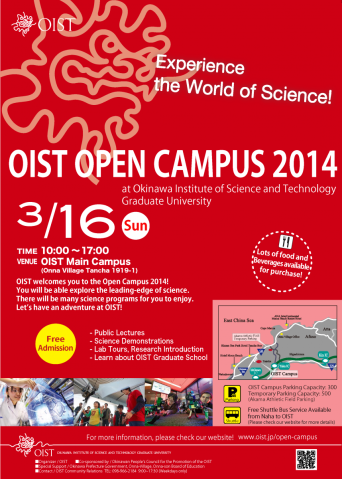Date :Sunday, March 16th, 2014
Time:10am-5pm
Venue:OIST Main Campus
1919-1 Tancha, Onna-son, Okinawa
Free Admission
Lecture(Target Age: over 12 years old)
1. Seeing the World Through Chemistry: What a View! @B250 Seminar Room(10:30-11:30)
Speaker:Sherida Johnson(Researcher, OIST Chemistry and Chemical Bioengineering Unit)
When you think of chemistry, do you think of mixing chemicals together with some fumes coming from a flask? Do you think it is quite complex? In this lecture, I will give a brief overview of what chemistry is and what you can do with a chemistry degree. Chemistry is all around us, leaving so much to explore and the “view” can be amazing.
2. Is Infinity Far Away? @B250 Seminar Room(12:00-13:00)
Speaker:Prof. Robert Sinclair(Associate Professor, OIST Mathematical Biology Unit)
Do numbers have locations? The standard kilogram is in a safe near Paris. Is there a place we can go to see "the standard number one"? Infinity is of course much more of a problem, but I plan to use a special trick to catch some of them for you. Yes, there will ne more than one!
3. Exploring the Origin of Mass: Higgs Particles @Auditorium (13:30-15:00)
If you hear “the origin of mass”, most of you may say, “What is it?” In the first place, maybe you have never thought about what mass is. However, if there is no mass in this world, the universe will collapse! In this lecture, I will introduce about Higgs Particle, which is strongly related to mass, and explain how we found them.
4. Exploring the Ultrafast World @B250 Seminar Room(15:30-16:30)
Speaker:Peter Hale(Researcher, OIST Femtosecond Spectroscopy Unit)
Science is all around us, often hiding in places we don't usually think to look. From quantum physics to chemistry, astronomy and even something as simple as the wing of a butterfly, we will take a look at some of the hidden beauty that can be found. As the title suggests, we will also take a tour of how the Femtosecond Spectroscopy Unit at OIST utilises laser pulses to explore the ultrafast world.
Science Programs (For All Ages)
Exploring the Microworld
Let’s take a look at cells of rats and marine bacteria with two different kinds of electron microscopes!
G0 Cell Unit Laboratory
You will be able to go inside of OIST laboratory, where usually you can’t see. Ask scientists there what they research about!
Zebra Fish Water Tank
Researchers at OIST raising over 400,000 zebra fish inside the high-tech water tank. You will be able to see those zebra fish and learn about what the scientists are trying to discover.
Hair-Raising Fun with Physics
Hands-on demonstrations letting you explore the effects of electricity and light in fun ways!
Programming with Neko-chan (*In order to participate, please request a ticket at the venue. 10 students per an hour)
Let’s do computer programming with Neko-chan! Together, we will learn how to use a programming language called SCRATCH. With SCRATCH, you can create stories, animations, even your own games!
Science at Sub Zero Degrees: Liquid Nitrogen and Dry Ice Fun Applications
How Do Robots Learn? Neuroscience Research using Robots
Let’s communicate with robots that OIST scientists use to study Neuroscience! Also you can experience programing using LEGO Mindstorm.
Synthesis of Small Molecules
Wonders of Ants
It is said that there are over 10,000 kinds of ants on the planet. Some of ants live together in organized communities, and this social system is similar to human society. Explore the unique characteristics of ants!
Mini Aquarium: Research Using Marine Animals
Did you know that octopuses are known as very intelligent animal? Did you know that world’s smallest octopus and squid can be found in the waters in Okinawa? Researchers at OIST use squids, cuttlefishes and octopuses from Okinawa to study genetics.
Fun with Physics
Through two science demonstrations, you can learn about viscosity and sound that is “visible”.
Providing a Safe Environment for Research:About Research Safety Section
In order to conduct cutting-edge research, it is essential to provide a safe environment for researchers.
High Performance Computing System
OIST’s computing system is several thousands times faster than regular computers. You can learn how we use those supercomputers for the research at OIST.
About Marine Research at OIST
Let's Look Into the Brain
Fron Molecules to Worms
And More!!
Study at OIST: Our Graduate School Program (Target age: for high school aged and above)
"What can I study at OIST?" "How do I apply to OIST?" We will tell you everything you need to know about our Graduate School.
Food Booth
- Café KaitoM
- Marusei Bento
- Delica Uotetsu
- Old Spice
- Miyabi Chaya
- Coconuts Moon
- Heshin
- Mame Pore-Pore
- SHIVA
- Village Market
- Captain Kangaroo
- Puka-puka Puuka
- Burger Shop H&S
- Café Plumeria
- Tonsaburo
- Aqui eStas
- Sara
- Lekkernijen
- Café Foresta
- Su-Su-Soon
- Half Time Cafe
Contact
Community Relations Section






